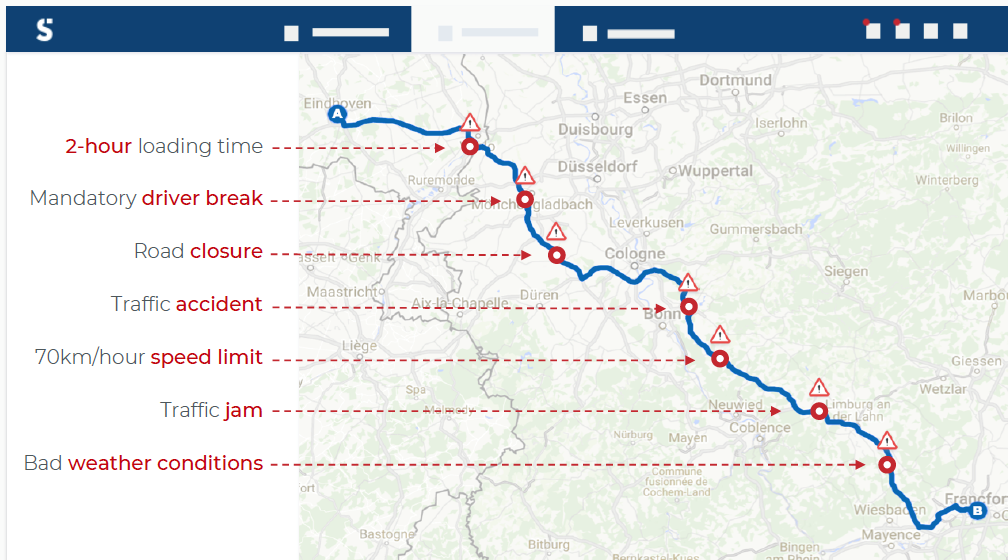Resilient Supply Chains and the Technology Behind Them
Supply chains are now more globalized and complex than ever. While this creates immense opportunities, it also exposes them to heightened risk. In the context of climate change, supply chain risks can mean operational disruptions caused by damage to vital infrastructure, fluctuations in demand, production shortfalls or logistics failures, particularly when transport routes and raw material sources are impacted by extreme weather. In complex supply chains, where materials and components are sourced from hundreds of suppliers globally, risk in one link of the chain exposes other parts to disruption. This risk is heightened further because companies have little visibility into operations outside of their own inventory.
Encouragingly, we are seeing innovations from both a mitigation and resilience perspective:
- Mitigation: Reducing supply chain emissions and improving the sustainability of materials and goods
- Resilience: Building in systems and processes to improve supply chain flexibility and adaptability to disruptions.
Innovating for Resilience
In the 2020 Global Risk Report, the World Economic Forum identified the likelihood of extreme weather events, natural disasters and climate action failure as the top three risks for business; it went on to identify failure to take climate change action as the top risk for business in terms of impact. Unsurprisingly, investors and lenders are increasingly using climate risk as a factor in measuring credit risk.
How can innovation in technology help? Digitization is key and it includes:
- Traceability and provenance
- Visibility
- Critical asset monitoring
- Predictive maintenance.
The digitization of these aspects improves resilience by providing data-driven, real-time, predictive intelligence into supply chain activity. It provides the tools to quickly react to potential disruptions. For example, if an extreme weather event impacts production at a manufacturing facility, a visibility platform would enable a quick shift to a different supplier. Combining this with predictive and prescriptive maintenance creates even more opportunities for disruption mitigation.
The recent impact of COVID-19 on supply chains has provided an extreme example of disruptions that are primarily caused by geographic production shortfalls and fluctuating supply and demand. The need for resilience measures- whether to increase visibility into upstream and downstream operations, predict disruptions, or improve adaptability- has become a necessity, not just a luxury, for smooth supply chain operations.
Traceability and Visibility
Product traceability and provenance is a cornerstone of supply chain resilience. Tracking what happens to a product along each link of a supply chain is the first step to solving issues of product sustainability, non-compliance and risk. Key drivers for product traceability are regulations, corporate commitments to the sustainable procurement of goods and mitigating negative press from product recalls. Current target markets consist primarily of agriculture and food products, high-value commodities and highly-regulated components and materials, such as airplane parts.
Visibility involves providing a connectivity and communication platform for upstream and downstream stakeholders to access and input information about orders, inventory and shipment status. This requires data normalization across systems, allowing for the integration of supply chain operations onto a single platform with real-time visibility. The resulting platforms improve agility and flexibility of the supply chains, creating quicker response times and improved adaptation to disruption.
Kezzler, a Norwegian startup, offers a cloud-based traceability platform that rests on serialization. The company partners with packaging companies to integrate unique identifiers into product packaging that are scanned as products move throughout the supply chain. The identifiers are scannable with a smart phone and anyone along the supply chain -including end customers- can scan the product to trace its origin as well as see how-and where- it has travelled to reach its destination.
The Swiss company Haelixa has developed a DNA-based barcode to mark and track materials and products. The DNA barcode kit is sent to materials suppliers to place on products and then provides proof of processing at any facility it passes through along the supply chain. To gather the data, Haelixa either integrates data collection with the client’s existing database or works with partners, such as blockchain platforms, to host the data. Haelixa’s focus is on data integrity and providing an undisputable history of a product’s journey.
Arviem is another Switzerland-based provider of supply chain visibility solutions via IoT-enabled real-time cargo tracking and monitoring solutions. Their solution includes a sensor attached to the back of containers that feeds information, including location, temperature, humidity levels and shocks, to a reporting platform via cellular networks. Arviem can provide estimated ETAs for cargo, risk management, working capital solutions and other services to mitigate humidity and damage to cargo.
Based in Paris, Tilkal operates a data network based on blockchain and a data platform to aggregate and analyze the data. Nodes of the blockchain network are deployed on the premises of different steps along the value chain, where the actors declare what happens to the products. Stakeholders along the supply chain can trace the origin of product and have a high-level view into inventories and stocks.
U.S-based Activ Technologies provides a SaaS platform for supply chain visibility. The platform is an integrated tech stack that connects individual trading partners by providing data integrity and normalization across systems. The platform provides real-time order status, inventory and shipment status as well as predictive analytics for disruptions to operations.
Shippeo, a startup based in France, recently raised a $21.8 million Series B round from NGP Capital, ETF Partners, BPI France and Partech Ventures. The company operates one of the leading supply chain visibility platforms in Europe with 5 million loads tracked annually for more than 50 customers. Shippeo’s platform can collect different types of data from different modes of transportation but their primary data source is the transportation management systems of carriers, which provide detailed information on a shipment’s starting location, ending location and the path it takes to get there.

Critical Asset Monitoring and Maintenance
Owners of critical supply chain assets, such as material extraction facilities, manufacturing plants and transportation infrastructure, have three main considerations:
- Protecting assets from physical or cyber threats
- Ensuring the assets are working properly and efficiently
- Optimizing operations to produce more, faster and at a lower cost.
Companies such as Palmos and SparkCognition are leveraging intelligent sensors, advanced analytics and artificial intelligence to help asset owners in the areas listed above.
SparkCognition uses artificial intelligence to offer more effective cybersecurity and predictive and prescriptive maintenance. Typically, analytics platforms ingest operational data from facilities and can take anywhere from weeks to months to develop operational models. With artificial intelligence, SparkCognition can automate model development, creating operational models within minutes. The technology can also ingest unstructured data from clients, allowing it to utilize more data sources than typical platforms. SparkCognition’s platform can predict if infrastructure will fail (predictive maintenance) and automatically query knowledge bases using deep natural language processing to decide on a course of action (prescriptive maintenance). The platform can then optimize operations to prevent malfunctions, optimize electricity use and reduce emissions, among other things.
Palmos uses vibration sensors and machines to analyze and predict localized climate risks, such as mudslides, that could impact critical transportation infrastructure. The sensors can operate in remote areas by using long range, low-power, wireless platforms. The Massachusetts-based company is backed by Greentown Labs, the Larta Institute, Cleantech Open, the USDA, Verizon and Columbia Engineering.
Business Models
Supply chain companies specializing in traceability and visibility generally offer their service as a platform that aggregates inputs from stakeholders, IoT devices, TMS or other sources. Some include a hardware component, such as sensors, barcode or other unique identifier, and others receive data from third party sources. Keeping capex investment low and providing integration with existing stakeholder systems using API keys is important for scalability of the platform.
Pay-per-X pricing is a common pricing scheme. For example, Arviem charges customers on a per-shipment basis, so the cost is tied to volume. Kezzler’s platform is offered for a recurring license fee, and the price depends on the volume of goods being tracked. Some platforms, such as Activ Technologies, offer their service as a monthly subscription basis, with price as a function of users and functionality, with no upfront cost for implementation. These pricing models also reflect a need to provide scalability and adapt to networks and shipments of all sizes.
Keep an Eye on…
The COVID-19 pandemic has created chaos in supply chains, exposing the value in having agile, resilient supply chain management. Supply chains are currently operating below capacity and drops in revenue have hindered investments in innovation in many cases. However, this crisis has spurred interest in digitalized solutions and this will likely be a significant area of investment in the coming years.


